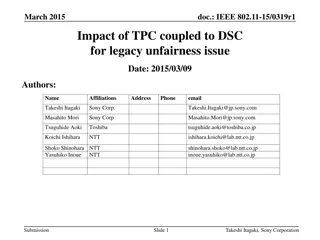
Engaging Fractions and Percentages Activity for Multiple Skill Levels
"This interactive math activity focuses on fractions, percentages, and area calculations suitable for students at levels 3 to 7. It involves basic to complex fraction and percentage operations, with options for different skill levels. The activity includes dissecting squares, calculating areas of shapes, and discussing real-life scenarios. Students work in pairs, utilize calculators, and engage in hands-on learning. Consumable and reusable resources are required, along with careful partner assignments. Enhance math skills with practical applications in a collaborative setting lasting 1-2 hours."
Download Presentation

Please find below an Image/Link to download the presentation.
The content on the website is provided AS IS for your information and personal use only. It may not be sold, licensed, or shared on other websites without obtaining consent from the author. If you encounter any issues during the download, it is possible that the publisher has removed the file from their server.
You are allowed to download the files provided on this website for personal or commercial use, subject to the condition that they are used lawfully. All files are the property of their respective owners.
The content on the website is provided AS IS for your information and personal use only. It may not be sold, licensed, or shared on other websites without obtaining consent from the author.
E N D
Presentation Transcript
If % conversions omitted 10* activity Suitable for students at Levels 3, 4, 5, 6 or even 7? Lots of additions / subtraction of simple (1/8, 1/16) etc. fractions Primarily about fractions and percentages. Includes calculation of areas of rectangles, with extensions to triangles and even circle areas. Standards Unit SS3: Dissecting a Square No cards in this activity. Activity takes 1-2 hours. Calculators needed to convert to % s. Must work in pairs. Lower level learners just focus on rectangles, not triangles.
Consumable Resources Needed: Each student needs 1off A5 copy of Sheet 1 There s a slightly easier version of this sheet if needed for some students (but no modelled answers yet produced for that sheet) Each student needs 1off A4 copy of Sheet 2 Re-usable Resources Needed:
Your name: Your name: This just means cutting into pieces This just means cutting into pieces
Your name: Your name: (Easier version) (Easier version) This just means cutting into pieces This just means cutting into pieces A A B B C C F F D E D E
Dissectors name: . Solver s name: . .. Spare grid, for workings out
Notes to start. Students must be pre-assigned with a partner. Pair work. Best if handouts are pre-distributed too in plastic wallets. Worksheets taken out when needed.
A roadsign Is it pointing Left or Right? North, South, East or West? Estimate what fraction is coloured white. Take your time to be more accurate. How could we measure what fraction is white?
What fraction of the sign is white? A year 6 student has tried to work it out, but made an error. Discuss with your partner what mistake has been made
Lucky Shopping? You decide to buy two pairs of trainers (they re 15% off!) and go to the checkout. The person at the checkout says: 15% off each item That will be 30% off the total price Is that what you expected to pay? Discuss it with your partner
Work with your partner to complete your worksheet Draw any lines, or workings out on here Remember this question too!
How have you calculated area C? Is there only one way to do it?
How do you convert a fraction to a %? 1 100 Percentages: % = How many hundredths of the whole? 1 8=1 8 100 Example: 100 =1 8 100 1 1 100 =1 % 8 100
Label the points to make it easier to talk about things. The square aceg is a of the full square remember. a g b f c e d Look at triangle ceg. Why is it half the area of the square? That s area F.
Now look at triangle bcg. a g b f c e d Triangle bcg is what is left of the square (aceg), after taking away two other triangles. Triangle ceg (area F) we know is of (1/8) Triangle abg is just of the square (1/16).
Full Answers 1 4 25% it said it on the sheet! 1 16 6.25% a quarter of A 3 16 5 16 1 16 1 8 18.75% three times B 31.25% area B + area A from previous slide, 1 4 1 1 16 8 6.25% 12.5% half of area A 1 100%
Your turn to dissect! Squares don t bleed or scream. Study the second worksheet
Dissect the Square D Divide the square into 7 or 8 different shape pieces by joining points on the grid with straight lines. B A C F E Then label each area. Complete the rest of the worksheet by working out the fractions and % shaded

